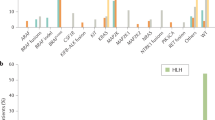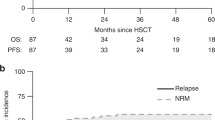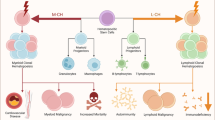Abstract
Hemophagocytic lymphohistiocytosis (HLH), also referred to as familial erythrophagocytic lymphohistiocytosis, is a rare disorder of infancy associated with proliferation of activated histiocytes and T cells, anemia, thrombocytopenia, and fevers. This disorder appears to be due to the uncontrolled activation of T cells producing IL-2, tumor necrosis factor-α, and interferon-γ. Untreated, the disorder is universally fatal. Various deficits in immune function have been described during acute disease activity including impaired T cell function, impaired monocytemediated antibody-dependent cytotoxicity, impaired natural killer cell function, and impaired IL-1 production. We examined natural killer cell function in familial HLH patients to determine whether this finding was consistently associated with the disease. We also examined natural killer cell function in asymptomatic parents and siblings of patients. Impaired natural killer cell function was identified in all patients and in some family members, including obligate carrier parents. This implies that one potential genetic defect in HLH may result in depressed natural killer function, but that this may not be sufficient to reliably predict eventual progression to disease.
Similar content being viewed by others
Main
Primary HLH, also known as familial erythrophagocytic lymphohistiocytosis when there is an associated family history, is a rapidly progressive disorder of uncertain etiology associated with fever, pancytopenia, hypertriglyceridemia, and hypofibrinogenemia (1,2). The genetic basis of this disorder is not known; however, an autosomal recessive pattern of inheritance is observed in familial cases (3). This disorder typically presents in infants or toddlers who were previously completely healthy. The initial symptoms are nonspecific and include fever and malaise. Hepatosplenomegaly and cytopenias develop, and there may be CNS involvement with lymphohistiocytic infiltrates. HLH was considered a fatal disorder of infancy until recently. Therapy with etoposide and steroids has been effective, and a few durable remissions have been achieved (4). However, at present, only bone marrow transplantation is considered curative. Early diagnosis and institution of therapy is essential.
A closely related disorder called viral-associated hemophagocytic syndrome, macrophage activation syndrome, or secondary HLH may be difficult to distinguish in the absence of a family history (5,6). This syndrome typically occurs after a viral infection in the setting of immunosuppression. The prognosis of secondary HLH and its natural history are markedly different from primary HLH or familial erythrophagocytic lymphohistiocytosis; however, it may be difficult to distinguish between the two. Viral triggers are thought to play a role in both disorders, and not all primary cases have a positive family history. A similar disease process is also seen in the accelerated phase of Chediak-Higashi syndrome, Griscelli syndrome, lysinuric protein intolerance, and in X-linked lymphoproliferative syndrome (7–11). The occurrence of these similar processes in settings of inherited or acquired immunodeficiency suggests that an underlying immunodeficiency could predispose to HLH.
Although there is no single diagnostic test for this disorder, diagnostic guidelines exist, and it is possible to establish the diagnosis early in the course with appropriate studies (12). Bone marrow, spleen, or liver biopsy is usually required to establish the diagnosis, and these invasive studies are often postponed until HLH has progressed to a life-threatening condition. In families with previously affected children, it would be desirable to identify whether other children are at risk. Laboratory studies that are useful diagnostically such as blood counts and triglyceride levels are completely normal in children until the disorder manifests itself. NK cell function has been described as being markedly decreased in patients during the evolution of the disease as well as in remission (13–17). We examined NK cell function in family members and patients with HLH, hypothesizing that NK cell dysfunction might be a genetic predisposing condition for this disorder.
METHODS
NK cell functional analysis. NK activity was measured in triplicates or quadruplicates using a standard chromium release assay against K562 cells, as previously described (18,19). Briefly, the K562 cells were resuspended in 51Cr-containing medium to label the cells. They were washed three times and plated into 96-well plates. The labeled K562 were incubated with Ficoll-purified peripheral blood mononuclear cells with the following effector to target ratios: 50:1, 25:1, 12.5:1, and 6.25:1. Negative control wells without effectors and maximal response wells were included for each patient and control subject. After a 4-h incubation, the supernatant was counted. Cytotoxicity was calculated as % cytotoxicity = (cytotoxic cpm - spontaneous cpm/maximal cpm - spontaneous cpm) × 100. LU were expressed as cytotoxicity per 106 cells. These studies were performed at three different sites with normative data established at each site. In Minnesota, the normal range is >4.0 LU. In Cincinnati, normative data are reestablished approximately every 6 mo using adult volunteers (>100 independent samples) and was most recently 4.25 ± 2.83 LU. Children referred as bone marrow transplant donors or recruited from an outpatient setting had a mean NK cell cytotoxicity of 5.1 + 4.3 LU. In Philadelphia, the adult normal control mean is 5.31 + 1.85 LU. In Philadelphia, variance over 7 mo time was measured for eight normal control subjects with a range of 4-8 separate assays. The variation ranged from 40-70% with a mean of 62%. NK cells were identified by flow cytometry using CD3-/CD16+/CD56+ criteria.
Patients. Study patients were diagnosed with HLH according to currently accepted diagnostic criteria (12). Family members were recruited and informed consent was obtained.
Case report. The proband is a male sibling of two HLH patients. An immunologic evaluation at 30 mo of age, while the patient was healthy, revealed normal immunoglobulin levels, peripheral blood lymphocyte subsets, T cell mitogen, and T cell antigen responses. NK cell function was markedly depressed. The study was repeated at 34 mo of age, and NK function remained markedly depressed.
This patient was followed prospectively for 15 mo. At 40 mo of age, he developed hepatosplenomegaly 2 wk after developing pansinusitis. Nine days later he was reevaluated for persistent fevers and found to have hypofibrinogenemia, hypertriglyceridemia, anemia, thrombocytopenia, and neutropenia. He was admitted and a bone marrow biopsy demonstrated histiocytic infiltrates with erythrophagocytosis. He was begun on etoposide and steriod and subsequently underwent a sibling-matched bone marrow transplant for primary HLH.
There were two previous childhood deaths in the family, with one sibling dying at 8 y of age from CNS HLH. Another sister died at 18 mo after presenting 8 mo previously with abnormal behavior, diarrhea, and fever. Lung, liver, and bone marrow biopsies were diagnostic of HLH. She was treated with cyclophosphamide and prednisone.
RESULTS
NK cell functional analysis was determined for 13 patients with HLH and 29 first degree relatives of the probands. All patients had absent or nearly absent NK cell function. A comparison of the mean HLH NK cell LU (0.06) with that of the adult (4.25 LU) or pediatric (5.1 LU) controls reveals a significant difference with p < 0.0001. In one patient, the analysis was performed prospectively and demonstrated that the NK cell abnormality antedated the onset of disease by at least 15 mo (see "Case History"). This is believed to be the first prospective study of NK function in a child at risk for HLH. Most families had at least one additional family member with abnormal NK cell function as determined by the standard K562 assay (Table 1). There was no differences in the mean LU for the parent group compared with controls, although there are clearly at least seven parents who had NK cell activity which was markedly decreased or absent. Although NK cell activity can fluctuate over time, no normal control has ever had absent NK cell activity. To date, none of the family members with decreased NK activity has developed HLH.
It is important to note that NK cells (defined by CD3-/CD16+/CD56+) were present in all cases of HLH (Table 2), and the defect was solely in the direct lysis of K562 cells.
A review of NK cell functional analysis in >100 adult control subjects and >50 normal children revealed no instances of absent NK cell function. This suggests that the finding is relevant to the disease process and not simply a normal population variant.
DISCUSSION
Seven previous studies documented abnormal NK cell function during the active phase of HLH (1,13,14,16,17,19,20). This led us to hypothesize that NK cell dysfunction could be used to identify individuals at high risk of developing HLH. Supporting the concept that NK cell dysfunction might be a primary part of the process and not simply secondary to the proliferative pxrocess is the finding that hemophagocytosis and a similar constellation of clinical findings can be seen in a variety of primary and secondary immunodeficiency states. We examined NK cell function in a cohort of patients with HLH and their first degree relatives in an effort to determine whether NK cell function was normal in healthy family members and whether absent NK function could be used prospectively to identify siblings at high risk of developing HLH.
These findings must be interpreted cautiously. Because NK dysfunction occurs in first degree relatives such as obligate carriers of patients with HLH, it will have limited use in selecting siblings of HLH patients who are at high risk of evolving that process. HLH typically presents in the first 2 y of life; however, older children are being recognized with increasing frequency. Therefore, we cannot be certain whether the older siblings in this study with abnormal NK function continue to be at risk from HLH or not. Additional longer term studies may yet determined whether normal NK cell function can define a low risk population of siblings. Identifying a low risk population could potentially be of benefit in selecting a donor for bone marrow transplantation and for family reassurance.
It is possible to hypothesize a role for NK cells in this disorder. If NK cell dysfunction is a precondition for primary HLH but not sufficient, then the relationship with secondary HLH becomes clearer. Perhaps the difference between primary HLH, which is usually not reversible without bone marrow transplantation, and secondary HLH, which can be reversible, is that the NK cell defect is reversible in secondary HLH and congenital in primary HLH. In this hypothesis, all of the different clinical conditions such as Griscelli syndrome or Chediak-Higashi syndrome, in which hemophagocytosis has been identified, have aberrant NK cell function as their common denominator. However, the NK cell defect appears to not be sufficient for expression of the disease in primary HLH. Current evidence supports a role for EBV infection of T cells and oligoclonal proliferation with secretion of macrophage-activating cytokines such as tumor necrosis factor and γ-interferon (21–23). Consistent with this hypothesis is the finding that similar viruses such as EBV and parvovirus B19 are associated with both primary and secondary forms of the disease and that overproduction of γ-interferon and tumor necrosis factor appears to be associated with both primary and secondary forms (15,24–26). In patients with congenital abnormalities of NK cell function, eradication of the virus may not be possible. The second precondition may relate to the susceptibility of the patients' T cells to viral infection. This clinical dichotomy is not without precedence. A similar situation occurs in another lymphoproliferative process in which Fas, a mediator of apoptosis, is defective (27). Only a subset of the heterozygous Fas-deficient individuals develop the proliferative process, suggesting an additional genetic or environmental factor is required for full expression of the disease (27).
Alternatively, absent or depressed NK activity may be a secondary effect that represents a consequence of the disturbed cytokine milieu described in HLH, including exaggerated secretion of IL-10 by T cells, an antagonist of IL-12 that stimulates NK activity (21,28). In this scenario, expression of a single copy of the HLH mutation could result in a cytokine imbalances impairing NK function, but would not be sufficient to permit the development of HLH. We conclude that decreased NK function is uniformly seen in patients with HLH, frequently seen in first degree relatives, and may be implicated in the disease process. Further studies will be required to define the potential role of prospective screening of family members to identify low risk siblings.
Abbreviations
- HLH:
-
hemophagocytic lymphohistiocytosis
- NK:
-
natural killer
- LU:
-
lytic unit
REFERENCES
Janka GE 1983 Familial erythrophagocytic lymphohistiocytosis. ur J Pediatr 140: 221–230
Hirst WJR, Layton DM, Singh S, Mieli-Vergani G, Chessells JM 1994 Haemophagocytic lymphohistiocytosis: experience at two U.K. centres. Br J Haematol 88: 731–739
Stark B, Hershko C, Rosen N, Cividalli G, Karsai H, Soffer D 1984 Familial hemophagocytic lymphohistiocytosis (FHLH) in Israel. Cancer 54: 2109–2121
Fischer A, Virelizier JL, Arenzana-Seisdedos F, Perez N, Nezelof C, Griscelli C 1985 Treatment of four patients with erythrophagocytic lymphohistiocytosis by a combination of epidophyllotoxin, steroids, intrathecal methotrexate, and cranial irradiation. Pediatrics 76: 263–268
Reiner A, Spivak JL 1988 Hemophagocytic histiocytosis. Medicine 67: 369–388
Chu T, D'Angio GJ, Favara B, Ladisch S, Nesbit M, Pritchard J 1987 Histiocytosis syndromes in children. Lancet 2: 41–42
Bejaoui M, Veber F, Girault C, Gaud C, Blanche S, Griscelli C, Fischer A 1989 Phase acceleree de la maladie de Chediak-Higashi. Arch Fr Pediatr 46: 733–736
Grierson H, Purtilo DT 1987 Epstein-Barr virus infections in males with the X-linked lymphproliferative syndrome. Ann Intern Med 106: 538–545
Roder JC, Haliotis T, Klein M, Korec S, Jett JR, Ortaldo J, Heberman RB, Katz P, Fauci AS 1980 A new immunodeficiency disorder in humans involving NK cells. Nature 284: 553–555
Parenti G, Sebastio G, Strisciuglio P, Incerti B, Pecoraro C, Terracciano L, Andria G 1995 Lysinuric protein intolerance characterized by bone marrow abnormalities and severe clinical course. J Pediatr 126: 246–251
Gogus S, Topcu M, Kucukali T, Akcoren Z, Berkel I, Gunay M, Saatci I 1995 Griscelli syndrome: report of three cases. Pediatr Pathol Lab Med 15: 309–319
Henter J-I, Elinder G, Ost A 1991 Diagnostic guidelines for hemophagocytic lymphohistiocytosis. Semin Oncol 18: 29–33
Kataoka Y, Todo S, Morioka Y, Sugie K, Nakamura Y, Yodoi J, Imashuku S 1990 Impaired natural killer activity and expression of interleukin-2 receptor antigen in familial erythrophagocytic lymphohistiocytosis. Cancer 65: 1937–1941
Stark B, Cohen IJ, Pecht M, Umiel T, Apte RN, Friedman E, Levin S, Vogel R, Schlesinger M, Zaizov R 1987 Immunologic dysregulation in a patient with familial hemophagocytic lymphohistiocytosis. Cancer 60: 2629–2636
Eife R, Janka GE, Belohradsky BH, Holtmann H 1989 Natural killer cell function and interferon production in familial hemophagocytic lymphohistiocytosis. Pediatr Hematol Oncol 6: 265–272
Arico M, Nespoli L, Maccario R, Montagna D, Bonetti F, Caselli D, Burgio GR 1988 Natural cytotoxicity impairment in familial haemophagocytic lymphohistiocytosis. Arch Dis Child 63: 292–296
Perez N, Virelizier JL, Arenzana-Seisdedos F, Fischer A, Griscelli C 1984 Impaired natural killer activity in lymphohistiocytosis syndrome. J Pediatr 104: 569–573
Egeler RM, Shapiro R, Loechelt B, Filipovitch AH 1996 Characteristic immune abnormalities in hemophagocytic lymphohistiocytosis. J Pediatr Hematol Oncol 18: 340–345
Baker KS, DeLaat C, Steinbuch MA, Gross TG, Shapiro RS, Loechelt B, Harris R, Filipovich AH 1997 Successful correction of hemophagocytic lymphohistiocytosis with related or unrelated bone marrow transplantation. Blood 89: 3857–3863
Arico M, Janka G, Fischer A, Henter JI, Blanche S, Elinder G, Martinetti M, Rusca MP 1996 Hemophagocytic lymphohistiocytosis. Report of 122 children from the international registry. FLH study group of the histiocyte society. Leukemia 10: 197–203
Osugi Y, Hara J, Tagawa S, Takai K, Hosoi G, Matsuda Y, Ohta H, Fujisaki H, Kobayashi M, Sakata N, Kawa-Ha K, Okada S, Tawa A 1997 Cytokine production regulating Th1 and Th2 cytokines in hemophagocytic lymphohistiocytosis. Blood 89: 4100–4103
Lay J-D, Tsao C-J, Chen J-Y, Kadin ME, Su I-J 1997 Upregulation of tumor necrosis factor-a gene by Epstein-Barr virus and activation of macrophages in Epstein-Barr virus infected T cells in the pathogenesis of hemophagocytic syndrome. J Clin Invest 100: 1969–1979
Kawaguchi H, Miyashita T, Herbst H, Niedobitek G, Asada M, Tsuchida M, Hanada R, Kinoshita A, Sakurai M, Kobayashi N, Mizutani S 1993 Epstein-Barr virus-infected T lymphocytes in Epstein-Barr virus-associated hemophagocytic syndrome. J Clin Invest 92: 1444–1450
McClain K, Gehrz R, Grierson H, Purtilo D, Filipovich AH 1988 Virus-associated histiocytic proliferations in children. Frequent association with Epstein-Barr virus and congenital or acquired immunodeficiencies. Am J Pediatr Hematol Oncol 10: 196–205
Kobayashi Y, Uehara S, Inamori K, Shirato R, Ozawa K, Sklar J, Asano S 1996 Hemophagocytosis as a paraneoplastic syndrome in NK cell leukemia. Int J Hematol 64: 135–142
Henter JI, Elinder G, Soder O, Hansson M, Andersson B, Andersson U 1991 Hypercytokinemia in familial hemophagocytic lymphohistiocytosis. Blood 78: 2918–2922
Drappa J, Vaishnaw AK, Sullivan KE, Chu J-L, Elkon KB 1996 Fas gene mutations in the Canale-Smith syndrome, an inherited lymphoproliferative disorder associated with autoimmunity. N Engl J Med 335: 1643–1649
Schneider EM, Harms B, Lorenz I, Stoldt V, Janka-Schaub GE 1996 Interferon-γ (IFN-γ) and interleukin 10 double positive T cells as potent activators of an uncontrolled hyperinflammatory response in patients with familial and infection-associated histiocytosis. Proceedings of the Histiocyte Society, Vienna, Astria
Acknowledgements
The authors thank Nancy Tustin, Susan Lee, Darryl Hake, and Terri Ellerhorst for excellent technical support. We thank the residents, fellows, and participating families for their contributions and enthusiasm.
Author information
Authors and Affiliations
Additional information
Supported in part by the Wallace Chair at the Children's Hospital of Philadelphia and the Ryan Marroco HLH Research Fund at Children's Hospital Medical Center.
Rights and permissions
About this article
Cite this article
Sullivan, K., Delaat, C., Douglas, S. et al. Defective Natural Killer Cell Function in Patients with Hemophagocytic Lymphohistiocytosis and in First Degree Relatives. Pediatr Res 44, 465–468 (1998). https://doi.org/10.1203/00006450-199810000-00001
Received:
Accepted:
Issue Date:
DOI: https://doi.org/10.1203/00006450-199810000-00001
This article is cited by
-
Macrophage activation syndrome complicating rheumatic diseases in adults: case-based review
Rheumatology International (2020)
-
Macrophage Activation Syndrome in Childhood Inflammatory Disorders: Diagnosis, Genetics, Pathophysiology, and Treatment
Current Treatment Options in Rheumatology (2020)
-
Evidence-based diagnosis and treatment of macrophage activation syndrome in systemic juvenile idiopathic arthritis
Pediatric Rheumatology (2015)
-
Deconstructing the diagnosis of hemophagocytic lymphohistiocytosis using illustrative cases
Journal of Hematopathology (2015)



